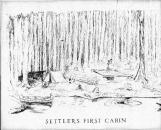15
When the Yorks and McDonells arrived at their land grants in the early spring of 1837 they found dense forests of pines and hardwoods. Their first task was to set up camp in tents and then clear a few trees and construct a very basic shelter out of the felled logs.17
After the construction of their first log home they proceeded with clearing the land. All the trees had to be cut down and limbed by hand using axes. The settlers would likely have had a team of horses or oxen to move the large timbers about.19
Much of the felled wood was burned as there was an over abundance of it. The ash would then be saved and used to fertilize the land once it was cleared to the point where a crop could be planted.21
When enough land was cleared the earth would be broken up using fairly crude tools. Care had to be taken to work around the remaining tree stumps which may not be removed for some time. In some cases the settler would craft a crude plough such as the "stump jumper plough" shown in the next illustration.23
The Stump Jumper PloughMany of the first settlers used this type of plough to break up their rough land. They had not been able to remove all the stumps and so had to work around them. The plough was home made out of a yolk from a felled tree. It was pulled by a slow moving team of oxen which gave the farmer time to lift the plough out of the ground as they approached the many stumps and roots that had not yet been cleared.
This is the only stump jumper plough that we know of in the Ottawa area.






